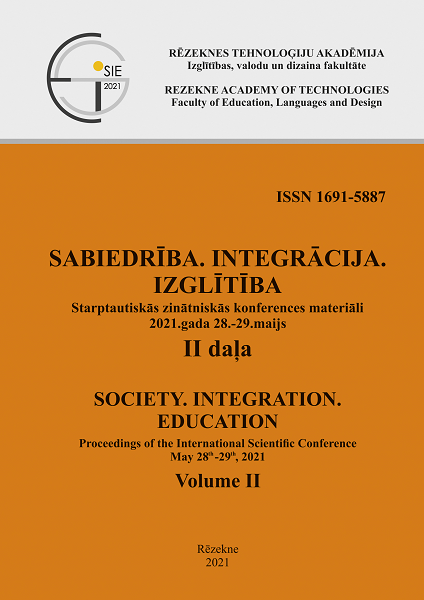EXPRESSION OF THE NEEDS OF THE CHARACTERS OF FAIRY TALES CREATED BY CHILDREN GROWING UP IN FAMILIES AT SOCIAL RISK AND THEIR SATISFACTION
DOI:
https://doi.org/10.17770/sie2021vol2.6292Keywords:
children’s voice, child’s needs, fairy tale created by a child, family at social risk, middle childhoodAbstract
The scientific literature analyses in detail the problems of a family at social risk, threats to the child’s social and personality development, etc., however, all insights are provided from an adult perspective – research that would allow the voice of a child growing up in a family at social risk to be heard has not been detected. Children have a limited ability to talk about their experiences. This is facilitated by the creation of a fairy tale, where the child, through the images of the characters created, can safely convey his/her individual life experiences. The aim of the article is to identify the expression of the needs of the characters of fairy tales created by children growing up in families at social risk and their satisfaction. Fairy tales created by 9‒12 year old children were selected as the object of analysis. Of the 69 texts written by children, 47 were selected for analysis. The content analysis of fairy tales was based on the principles of phenomenological hermeneutics. The analysis of fairy tales created by children growing up in families at social risk shows that the characters of the fairy tales they create experience the following unmet needs: physiological, security and social. Heroes of the fairy tales of children growing up in families at social risk are not prone to solving problems, it is more comfortable for them to live as usual, although not always they feel good because of that.
Downloads
References
Applebee, A. N. (1978). The child’s concept of story: ages two to seventeen. Chicago: University of Chicago Press.
Bražienė, N. (2018). Fairy World of the Texts Created by 8‒11 Year Old Children. In Juodaitytė, A., Malinauskienė, D., Musneckienė, E., Bražienė, N., Lenkauskaitė, J. Contemporary childhood and education of children: social-cultural contexts: Study. Šiauliai: Šiaulių universitetas, 137‒186.
Broström, S. (2002). Children tell stories. European Early Childhood Education Research Journal, 10(1), 85-97. DOI: 10.1080/13502930285208861
Dobelniece, S., Millere, J., & Salmane-Kuļikovska, I. (2015). Situation analysis of social risk families with children in Latvia. Proceedings of the 2015 International Conference “Economic Science for Rural Development”, 40, 141‒150. Retrieved from https://llufb.llu.lv/conference/economic_science_rural/2015/Latvia_ESRD_40_2015-141-150.pdf
Eccles, J. (1999). The Development of Children Ages 6 to 14. The Future of Children, 9(2), 30‒44. Retrieved from https://doi.org/10.2307/1602703
Erikson, E. H. (2004). Vaikystė ir visuomenė. Vilnius: Katalikų pasaulio leidiniai.
Halász, G., & Michel, A. (2011). Key Competences in Europe: interpretation, policy formulation and implementation. European Journal of Education, 46 (3), 289–306. Retrieved from https://doi.org/10.1111/j.1465-3435.2011.01491.x
Gazelle, H., & Druhen, M. J. (2009). Anxious solitude and peer exclusion predict social helplessness, upset affect, and vagal regulation in response to behavioral rejection by a friend. Developmental Psychology, 45(4), 1077–1096. Retrieved from https://doi.org/10.1037/a0016165
Gudzinskiene, V., & Augutavicius, R. (2018). The phenomenon of social risk families and its dynamics in Lithuania. SHS Web of Conferences, 51, 03001. DOI: 10.1051/shsconf/20185103001
Juodaitytė, A. (2002). Socializacija ir ugdymas vaikystėje. Vilnius: Petro ofsetas.
Karlsson, L. (2013). Storycrafting method–to share, participate, tell and listen in practice and research. The European Journal of Social & Behavioural Sciences (eISSN: 2301-2218), 1109‒1117. Retrieved from http://dx.doi.org/10.15405/ejsbs.88
Kondrotaitė, G., & Butvilas, T. (2007). The socialization of children from social risk families: the analysis of experienced loss influence to their behaviour. Social Work, 6(1), 96‒103. Retrieved from https://www3.mruni.eu/ojs/social-work/article/view/2073/1883
Livesley, J., & Long, T. (2013). Children’s experiences as hospital in-patients: Voice, competence and work. Messages for nursing from a critical ethnographic study. International Journal of Nursing Studies, 50(10), 1292‒1303. DOI: 10.1016/j.ijnurstu.2012.12.005
Maybin, J. (2012). Towards a sociocultural understanding of children’s voice. Language and Education, 27(5), 1‒15. DOI: 10.1080/09500782.2012.704048
Maranda, E., & Maranda, K. (1971). Structural Models in Folklore and Transformational Essays. The Hague Mouton.
Masiliauskienė, E., & Griškutė, V. (2010). Empirical research on contexts of manifestation of support provided by children day care centres for children from social risk families. Teacher Education, 14 (1), 138–155. Retrieved from http://gs.elaba.lt/object/elaba:6105163/6105163.pdf
Malinauskienė, D., & Juodaitytė, A. (2019). Researcher in Childhood Research: Attitudes, Beliefs, Their Manifestation and Change. Pedagogy, 136(4), 5–16. Retrieved from https://doi.org/10.15823/p.2019.136.1
Maslow, A. H. (2006). Motyvacija ir asmenybė. Vilnius: Apostrofa.
Nimante, D., Gehtmane-Hofmane, I., & Vasečko, L. (2018). Children’s Voice and Decision Making in Institutional Care in Latvia. 11th annual International Conference of Education, Research and Innovation. Retrieved from doi: 10.21125/iceri.2018.2481
Nicolopoulou, A. (2011). Children’s Storytelling: Toward an Interpretive and Sociocultural Approach. Storyworlds: A Journal of Narrative Studies, 3, 25‒48. DOI: 10.1353/stw.2011.0002
Oaklander, V. (2007). Langas į vaiko pasaulį. Kaunas: Žmogaus psichologijos studija.
Preece, A. (1987). The range of narrative forms conversationally produced by young children. Journal of child language, 14(2). Cambridge University Press, 353–373. Retrieved from https://doi.org/10.1017/S0305000900012976
Propp, V. (1968; seventeenth paperback printing, 2003). Morphology of the Folktale. Austin: University of Texas Press. Retrieved from https://monoskop.org/images/f/f3/Propp_Vladimir_Morphology_of_the_Folktale_2nd_ed.pdf
Rodari, G. (2001). Fantazijos gramatika. Kaunas: Šviesa.
Rouvali, A. & Riga, V. (2018). Redefining the importance of children’s voices in personal social emotional development curriculum using the Mosaic Approach. Education. International Journal of Primary, Elementary and Early Years Education, 3‒13, 47, 998‒1013. Retrieved from https://doi.org/10.1080/03004279.2018.1553990
Sutton-Smith, B. (1981). The Folkstories of Children. University of Pennsylvania.
Tangen, R. (2008). Listening to children’s voices in educational research: some theoretical and methodological problems. European Journal of Special Needs Education, 23(2), 157‒166. DOI:10.1080/08856250801945956
Tay-Lim, J., & Lim, S. (2013). Privileging Younger Children’s Voices in Research: Use of Drawings and a Co-Construction Process. International Journal of Qualitative Methods, 12(1), 65‒83. Retrieved from https://doi.org/10.1177/160940691301200135
Urbina-García, M. (2019). Methodological Strategies to Listen to Children’s Voices: A Systematic Critical Review. Revista Colombiana de Educación, 77, 61‒85. Retrieved from https://doi.org/10.17227/rce.num77-9650
Zandere, I. (2007). Skaitančio vaiko likimas Latvijoje. Rubinaitis, 2 (42). Retrieved from http://rubinaitis.lnb.lt/index.php?3835162739


